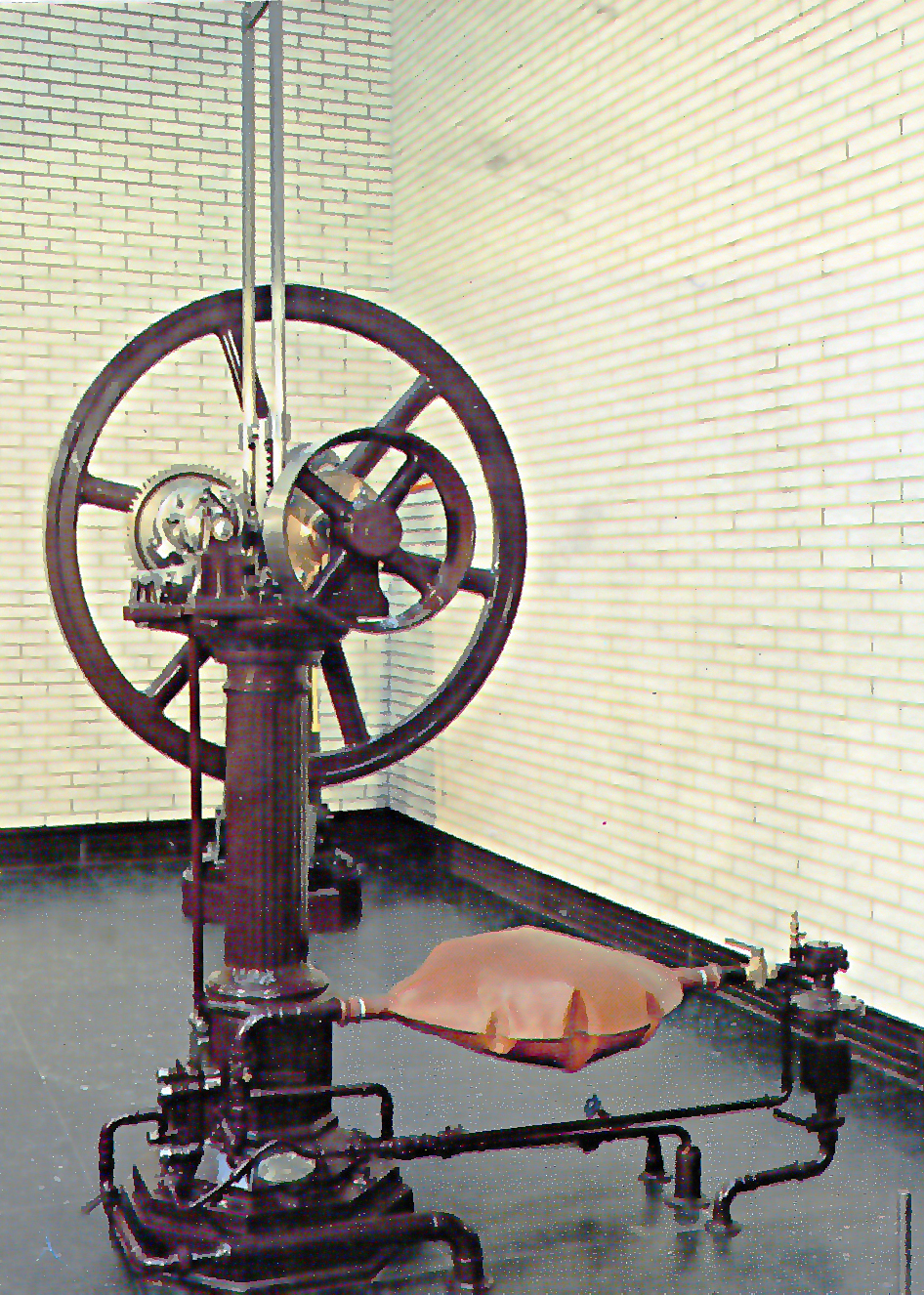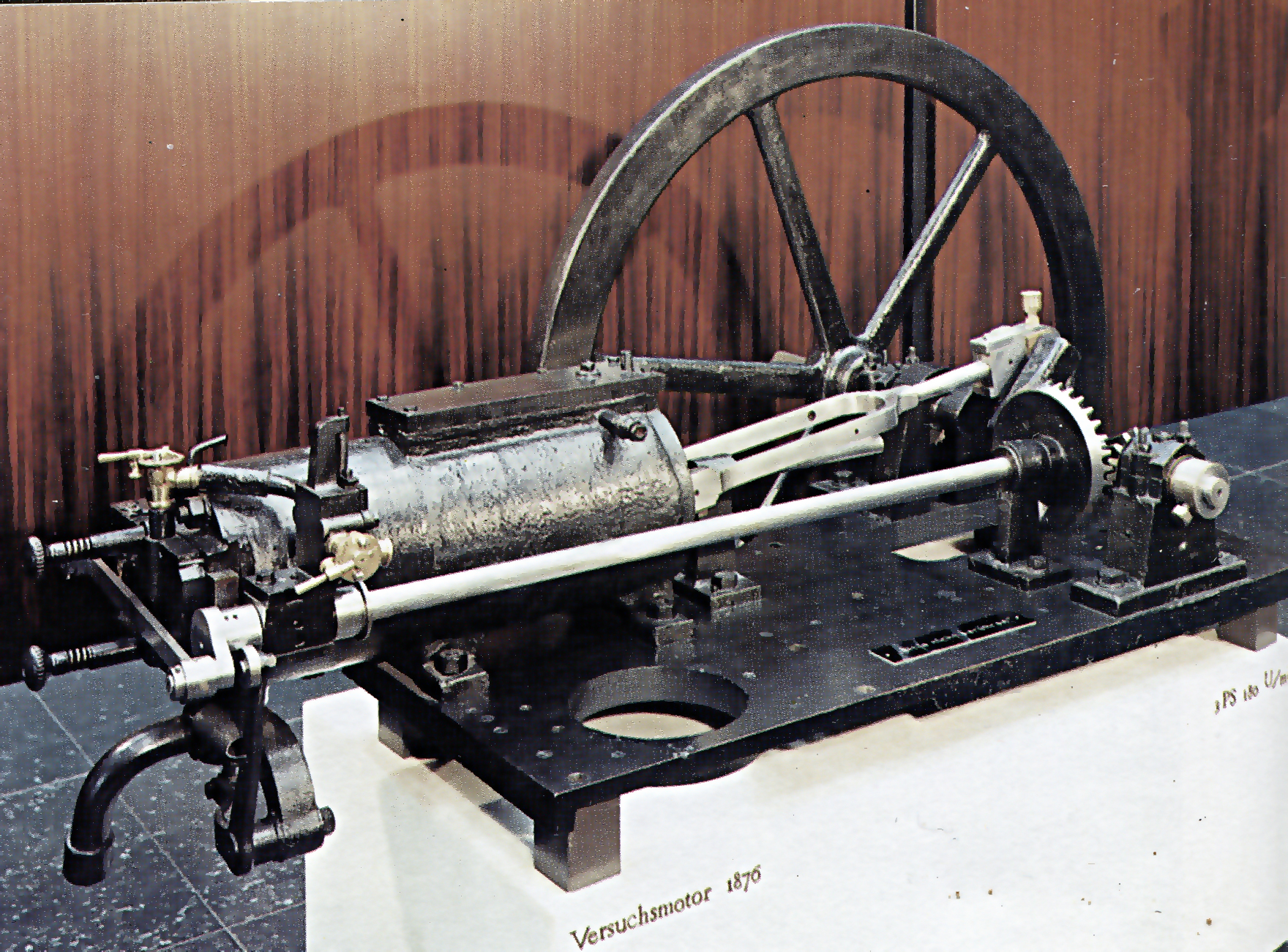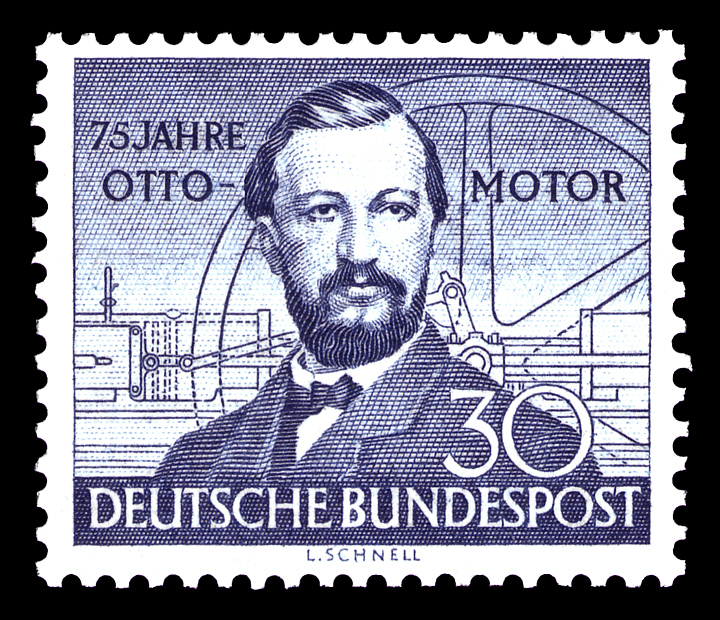Nicolaus August Otto on:
[Wikipedia]
[Google]
[Amazon]


 Nicolaus August Otto (10 June 1832, Holzhausen an der Haide,
Nicolaus August Otto (10 June 1832, Holzhausen an der Haide,
 Nicolaus August Otto was born on 10 June 1832 in Holzhausen an der Haide, Germany. He was the youngest of six children. His father died in 1832. He began school in 1838. After six years of good performance he moved to the high school in Langenschwalbach until 1848. He did not complete his studies but was cited for good performance.
His main interest in school had been in science and technology but he graduated after three years as a business apprentice in a small merchandise company. After completing his apprenticeship he moved to Frankfurt where he worked for Philipp Jakob Lindheimer as a salesman of
Nicolaus August Otto was born on 10 June 1832 in Holzhausen an der Haide, Germany. He was the youngest of six children. His father died in 1832. He began school in 1838. After six years of good performance he moved to the high school in Langenschwalbach until 1848. He did not complete his studies but was cited for good performance.
His main interest in school had been in science and technology but he graduated after three years as a business apprentice in a small merchandise company. After completing his apprenticeship he moved to Frankfurt where he worked for Philipp Jakob Lindheimer as a salesman of


 Nicolaus August Otto (10 June 1832, Holzhausen an der Haide,
Nicolaus August Otto (10 June 1832, Holzhausen an der Haide, Nassau
Nassau may refer to:
Places Bahamas
*Nassau, Bahamas, capital city of the Bahamas, on the island of New Providence
Canada
*Nassau District, renamed Home District, regional division in Upper Canada from 1788 to 1792
*Nassau Street (Winnipeg), ...
– 26 January 1891, Cologne
Cologne ( ; german: Köln ; ksh, Kölle ) is the largest city of the German western state of North Rhine-Westphalia (NRW) and the fourth-most populous city of Germany with 1.1 million inhabitants in the city proper and 3.6 millio ...
) was a German engineer
Engineers, as practitioners of engineering, are professionals who Invention, invent, design, analyze, build and test machines, complex systems, structures, gadgets and materials to fulfill functional objectives and requirements while considerin ...
who successfully developed the compressed charge internal combustion engine which ran on petroleum gas and led to the modern internal combustion engine. The Association of German Engineers
Verein Deutscher Ingenieure (VDI) (English: Association of German Engineers) is an organization of over 150,000 engineers and natural scientists. More than 12,000 honorary experts process the latest technical findings each year to promote the techn ...
(VDI) created DIN standard 1940 which says "Otto Engine: internal combustion engine in which the ignition of the compressed fuel-air mixture is initiated by a timed spark", which has been applied to all engines of this type since.
Biography
 Nicolaus August Otto was born on 10 June 1832 in Holzhausen an der Haide, Germany. He was the youngest of six children. His father died in 1832. He began school in 1838. After six years of good performance he moved to the high school in Langenschwalbach until 1848. He did not complete his studies but was cited for good performance.
His main interest in school had been in science and technology but he graduated after three years as a business apprentice in a small merchandise company. After completing his apprenticeship he moved to Frankfurt where he worked for Philipp Jakob Lindheimer as a salesman of
Nicolaus August Otto was born on 10 June 1832 in Holzhausen an der Haide, Germany. He was the youngest of six children. His father died in 1832. He began school in 1838. After six years of good performance he moved to the high school in Langenschwalbach until 1848. He did not complete his studies but was cited for good performance.
His main interest in school had been in science and technology but he graduated after three years as a business apprentice in a small merchandise company. After completing his apprenticeship he moved to Frankfurt where he worked for Philipp Jakob Lindheimer as a salesman of colonial goods In economics, colonial goods are goods imported from European colonies, in particular coffee, tea, spices, rice, sugar, cocoa and chocolate, and tobacco.
At a time when food and agriculture represented a relatively large proportion of overall eco ...
and agricultural products (he was a grocery salesman). Otto worked for various companies, first for IC Alpeter and then in 1860 for Carl Mertens. He traveled throughout Western Germany and sold colonial goods—coffee, tea, rice, and sugar.
Lenoir engine
In late autumn of 1860 Otto and his brother learned of a novel gas ( illuminating gas) engine that Jean Joseph Etienne Lenoir had built in Paris. The brothers built a copy of the Lenoir engine and applied for a patent in January 1861 for a liquid fueled engine based on the Lenoir (Gas) engine with the Prussian Ministry of Commerce, but it was rejected.First four stroke engine, 1861
Otto was aware of the concept of compressed fuel charge and tried to make an engine using this principle in 1861. It ran for just a few minutes before breaking. Otto's brother gave up on the concept, resulting in Otto looking for help elsewhere. From 1862 to 1863 Otto experimented with the help of Cologne Mechanic Michael J. Zons in an effort to improve the engine. Running low on funds, in 1862 Otto worked for Carl Mertens in order to continue work on his engine.Partnership with Eugen Langen
Early in 1864, Otto sought investors to fund his research. He found Eugen Langen, whose father was a sugar industrialist. Together they entered into a partnership on 31 March 1864 and named it NA Otto & Cie in Cologne. This was the world's first company focused entirely on the design and production of internal combustion engines. The 1864 Otto & Langen engine was a free pistonatmospheric engine
The atmospheric engine was invented by Thomas Newcomen in 1712, and is often referred to as the Newcomen fire engine (see below) or simply as a Newcomen engine. The engine was operated by condensing steam drawn into the cylinder, thereby creati ...
(the explosion of gas was used to create a vacuum and the power came from atmospheric pressure returning the piston). It consumed less than half the gas of the Lenoir and Hugon atmospheric engines and so was a commercial success. The Lenoir engine was a double acting engine. In essence these engines are a steam engine altered to run on illuminating gas. The engines of Italian inventors Eugenio Barsanti and Felice Matteucci
Felice Matteucci (February 12, 1808 – September 13, 1887) was an Italian hydraulic engineer who co-invented an internal combustion engine with Eugenio Barsanti. Their patent request was granted in London on June 12, 1854, and published in L ...
in their British Patent no 1625 of 1857, were built and are in a museum. Unlike Otto's engine these are two stroke atmospheric engines which are not in any way comparable.
Lenoir's engines were the first to be put into serial production with numbers sold being around 700.
The Otto engine which is the predecessor of the modern engine as specified by the VDI is Otto's fourth design. He built the following engines:
*1861: a copy of Lenoir's atmospheric engine
*1862: a four cycle compressed charge engine (prior to Rochas's patent) which failed as it broke almost immediately
*1864: the first successful atmospheric engine
*1876: the four stroke
A four-stroke (also four-cycle) engine is an internal combustion (IC) engine in which the piston completes four separate strokes while turning the crankshaft. A stroke refers to the full travel of the piston along the cylinder, in either directi ...
compressed charge engine which is acknowledged as the "Otto" cycle engine. The term "Otto cycle" is applied to all compressed charge, four cycle engines.
For all its commercial success, with the company producing 634 engines a year by 1875, the Otto and Langen engine had hit a technical dead end: it produced only , yet required headroom to operate.Wise, p.482.
Otto turned his attention to the four stroke cycle at which he had failed in 1862. Largely due to the efforts of Franz Rings and Herman Schumm, who were brought into the company by Gottlieb Daimler
Gottlieb Wilhelm Daimler (; 17 March 1834 – 6 March 1900) was a German engineer, industrial designer and industrialist born in Schorndorf ( Kingdom of Württemberg, a federal state of the German Confederation), in what is now Germany. He w ...
Otto succeeded in making the Four Stroke, Compressed Charge engine. It is this engine (the Otto Silent Engine), and not the Otto & Langen engine, to which the "Otto cycle" refers. This was the first commercially successful engine to use in-cylinder compression. The Rings-Schumm engine appeared in autumn 1876 and was immediately successful.
Otto married Anna Gossi and the couple had seven recorded children. His son Gustav Otto grew up to become an aircraft builder.
The Otto cycle
TheOtto engine
The Otto engine was a large stationary single-cylinder internal combustion four-stroke engine designed by the German Nicolaus Otto. It was a low-RPM machine, and only fired every other stroke due to the Otto cycle, also designed by Otto.
Typ ...
was designed as a stationary engine and in the action of the engine, the stroke is an upward or downward movement of a piston in a cylinder. Used later in an adapted form as an automobile
A car or automobile is a motor vehicle with wheels. Most definitions of ''cars'' say that they run primarily on roads, seat one to eight people, have four wheels, and mainly transport people instead of goods.
The year 1886 is regarded ...
engine
An engine or motor is a machine designed to convert one or more forms of energy into mechanical energy.
Available energy sources include potential energy (e.g. energy of the Earth's gravitational field as exploited in hydroelectric power ...
, four strokes are involved:
*(1) downward ''intake'' stroke— coal-gas and air enter the piston combustion chamber
A combustion chamber is part of an internal combustion engine in which the fuel/air mix is burned. For steam engines, the term has also been used for an extension of the firebox which is used to allow a more complete combustion process.
Intern ...
,
*(2) upward ''compression'' stroke—the piston
A piston is a component of reciprocating engines, reciprocating pumps, gas compressors, hydraulic cylinders and pneumatic cylinders, among other similar mechanisms. It is the moving component that is contained by a cylinder and is made gas-t ...
compresses the mixture,
*(3) downward ''power'' stroke—ignites the fuel mixture
A fuel is any material that can be made to react with other substances so that it releases energy as thermal energy or to be used for work. The concept was originally applied solely to those materials capable of releasing chemical energy bu ...
by flame and later electric spark
An electric spark is an abrupt electrical discharge that occurs when a sufficiently high electric field creates an ionized, electrically conductive channel through a normally-insulating medium, often air or other gases or gas mixtures. Michael F ...
,
*(4) upward ''exhaust'' stroke—releases exhaust gas
Exhaust gas or flue gas is emitted as a result of the combustion of fuels such as natural gas, gasoline (petrol), diesel fuel, fuel oil, biodiesel blends, or coal. According to the type of engine, it is discharged into the atmosphere through an ...
from the piston chamber.
Otto only sold his engine as a stationary motor.
Earlier patents
Otto had obtained many patents from several different nations and for several different features. When his former manager Gottlieb Daimler wanted to build small engines for transportation Otto showed no interest. Daimler left and took Maybach with him. Daimler had no desire to pay royalties to Otto (Deutz AG
Deutz AG is a German internal combustion engine manufacturer, based in Porz, Cologne, Germany.
History
The company was founded by Nicolaus Otto, the inventor of the four-stroke internal combustion engine, and his partner Eugen Langen on 31 ...
) and so hired a lawyer to find a solution. What the lawyer found was a patent for the concept of a four cycle engine that had been issued to Beau De Rochas, a French engineer, in 1862. This resulted in Otto losing one of his patents and allowed Daimler to sell his engines in Germany without paying royalties. Neither Otto nor Daimler were aware of the Rochas patent. Rochas never built an engine. It is likely he could not have done so.
Several of the inventions that are sometimes mentioned as having preceded the Otto engine, such as Marcus, Barsanti, etc. are for two cycle (two stroke) atmospheric engines which do not compress the fuel charge. Otto's atmospheric engine is not the VDI (and other associations) Otto engine type. The only significant engines were those from Lenoir. His engines were the first to go into serial production. Lenoir eventually sold approximately 700 engines.
Production
Over 50,000 engines were produced in the 17 years following introduction.Honors
Otto received numerous honors for his engines. *The 1864 atmospheric engine won the gold medal in the 1867 World Exhibition in Paris. *In 1882 Otto received an Honorary Doctorate from theUniversity of Würzburg
The Julius Maximilian University of Würzburg (also referred to as the University of Würzburg, in German ''Julius-Maximilians-Universität Würzburg'') is a public research university in Würzburg, Germany. The University of Würzburg is one of ...
.
*His home has been turned into a museum which is promoted by the local government.
*in 1936 Professor Nagël, head of the Association of German Engineers, decreed that DIN Standard 1940 specify that "Ottomotor" applies to all engines that draw in a fuel mix, compress it and ignite it by special device, thus replacing the terms such terms as "explosion motor", "detonation engine", "benzine engine", and "ignition engine."
Milestones
*1862: First experiments with four-stroke engines *1864: Establishing the first engine factory in the world: ''NA Otto Cie'' *1867: Gold Medal of the World Exhibition in Paris for the gas engine *1869: The company relocates and changes its name to ''Langen, Otto, and Roosen'' *1872: The company relocates to larger facilities and changes its name to ''Deutz Gasmotoren Fabrik'' *1876: Development of four-stroke engine (Otto-motor) *1882: Production of the Atmospheric engine is discontinued after 2649 were made *1884: Nicolaus Otto invents the electric ignition *1885: Gottlieb Daimler andKarl Benz
Carl Friedrich Benz (; 25 November 1844 – 4 April 1929), sometimes also Karl Friedrich Benz, was a German engine designer and automotive engineer. His Benz Patent Motorcar from 1885 is considered the first practical modern automobile and fi ...
built the first automobiles using liquid petroleum engines.
See also
*History of the internal combustion engine
Various scientists and engineers contributed to the development of internal combustion engines. In 1791, the English inventor John Barber patented a gas turbine. In 1794 Thomas Mead patented a gas engine. Also in 1794 Robert Street patented an i ...
* German inventors and discoverers
References
* Wise, David Burgess. "Daimler: Founder of the Four-Wheeler", in Northey, Tom, ed. ''World of Automobiles'' Volume 5, pp. 481–3. London: Orbis, 1974.External links
* —1877 * {{DEFAULTSORT:Otto, Nicolaus 1832 births 1891 deaths 19th-century German inventors German company founders 19th-century German businesspeople German industrialists People associated with the internal combustion engine Articles containing video clips